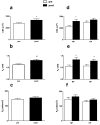Protein Supplementation Does Not Further Increase Latissimus Dorsi Muscle Fiber Hypertrophy after Eight Weeks of Resistance Training in Novice Subjects, but Partially Counteracts the Fast-to-Slow Muscle Fiber Transition
- PMID: 27258300
- PMCID: PMC4924172
- DOI: 10.3390/nu8060331
Protein Supplementation Does Not Further Increase Latissimus Dorsi Muscle Fiber Hypertrophy after Eight Weeks of Resistance Training in Novice Subjects, but Partially Counteracts the Fast-to-Slow Muscle Fiber Transition
Abstract
The response to resistance training and protein supplementation in the latissimus dorsi muscle (LDM) has never been investigated. We investigated the effects of resistance training (RT) and protein supplementation on muscle mass, strength, and fiber characteristics of the LDM. Eighteen healthy young subjects were randomly assigned to a progressive eight-week RT program with a normal protein diet (NP) or high protein diet (HP) (NP 0.85 vs. HP 1.8 g of protein·kg(-1)·day(-1)). One repetition maximum tests, magnetic resonance imaging for cross-sectional muscle area (CSA), body composition, and single muscle fibers mechanical and phenotype characteristics were measured. RT induced a significant gain in strength (+17%, p < 0.0001), whole muscle CSA (p = 0.024), and single muscle fibers CSA (p < 0.05) of LDM in all subjects. Fiber isometric force increased in proportion to CSA (+22%, p < 0.005) and thus no change in specific tension occurred. A significant transition from 2X to 2A myosin expression was induced by training. The protein supplementation showed no significant effects on all measured outcomes except for a smaller reduction of 2X myosin expression. Our results suggest that in LDM protein supplementation does not further enhance RT-induced muscle fiber hypertrophy nor influence mechanic muscle fiber characteristics but partially counteracts the fast-to-slow fiber shift.
Keywords: myosin isoform; nutrition; single muscle fiber mechanics; strength training; supplementation; whey protein.
Figures







Similar articles
-
Protein Supplementation Augments Muscle Fiber Hypertrophy but Does Not Modulate Satellite Cell Content During Prolonged Resistance-Type Exercise Training in Frail Elderly.J Am Med Dir Assoc. 2017 Jul 1;18(7):608-615. doi: 10.1016/j.jamda.2017.02.006. Epub 2017 Apr 1. J Am Med Dir Assoc. 2017. PMID: 28377156 Clinical Trial.
-
Myosin isoforms and contractile properties of single fibers of human Latissimus Dorsi muscle.Biomed Res Int. 2013;2013:249398. doi: 10.1155/2013/249398. Epub 2013 Jul 22. Biomed Res Int. 2013. PMID: 23971027 Free PMC article.
-
Muscle strength and hypertrophy occur independently of protein supplementation during short-term resistance training in untrained men.Appl Physiol Nutr Metab. 2015 Aug;40(8):797-802. doi: 10.1139/apnm-2015-0027. Epub 2015 Mar 23. Appl Physiol Nutr Metab. 2015. PMID: 26154345 Clinical Trial.
-
Muscle mechanics: adaptations with exercise-training.Exerc Sport Sci Rev. 1996;24:427-73. Exerc Sport Sci Rev. 1996. PMID: 8744258 Review.
-
Muscle Fiber Hypertrophy and Myonuclei Addition: A Systematic Review and Meta-analysis.Med Sci Sports Exerc. 2018 Jul;50(7):1385-1393. doi: 10.1249/MSS.0000000000001593. Med Sci Sports Exerc. 2018. PMID: 29509639
Cited by
-
Resistance training induced changes in strength and specific force at the fiber and whole muscle level: a meta-analysis.Eur J Appl Physiol. 2019 Jan;119(1):265-278. doi: 10.1007/s00421-018-4022-9. Epub 2018 Oct 24. Eur J Appl Physiol. 2019. PMID: 30357517
-
Identifying the Structural Adaptations that Drive the Mechanical Load-Induced Growth of Skeletal Muscle: A Scoping Review.Cells. 2020 Jul 9;9(7):1658. doi: 10.3390/cells9071658. Cells. 2020. PMID: 32660165 Free PMC article.
-
Using the Hephaistos orthotic device to study countermeasure effectiveness of neuromuscular electrical stimulation and dietary lupin protein supplementation, a randomised controlled trial.PLoS One. 2017 Feb 16;12(2):e0171562. doi: 10.1371/journal.pone.0171562. eCollection 2017. PLoS One. 2017. PMID: 28207840 Free PMC article. Clinical Trial.
-
Nutrition, Pharmacological and Training Strategies Adopted by Six Bodybuilders: Case Report and Critical Review.Eur J Transl Myol. 2017 Mar 24;27(1):6247. doi: 10.4081/ejtm.2017.6247. eCollection 2017 Feb 24. Eur J Transl Myol. 2017. PMID: 28458804 Free PMC article.
-
Advances in Sport and Performance Nutrition.Nutrients. 2019 Mar 2;11(3):538. doi: 10.3390/nu11030538. Nutrients. 2019. PMID: 30832303 Free PMC article.
References
-
- Staron R.S., Leonardi M.J., Karapondo D.L., Malicky E.S., Falkel J.E., Hagerman F.C., Hikida R.S. Strength and skeletal muscle adaptations in heavy-resistance-trained women after detraining and retraining. J. Appl. Physiol. 1991;70:631–640. - PubMed
-
- Tesch P.A., Thorsson A., Kaiser P. Muscle capillary supply and fiber type characteristics in weight and power lifters. J. Appl. Physiol. Respir. Environ. Exerc. Physiol. 1984;56:35–38. - PubMed
MeSH terms
Substances
LinkOut - more resources
Full Text Sources
Other Literature Sources
Medical
Research Materials
Miscellaneous

